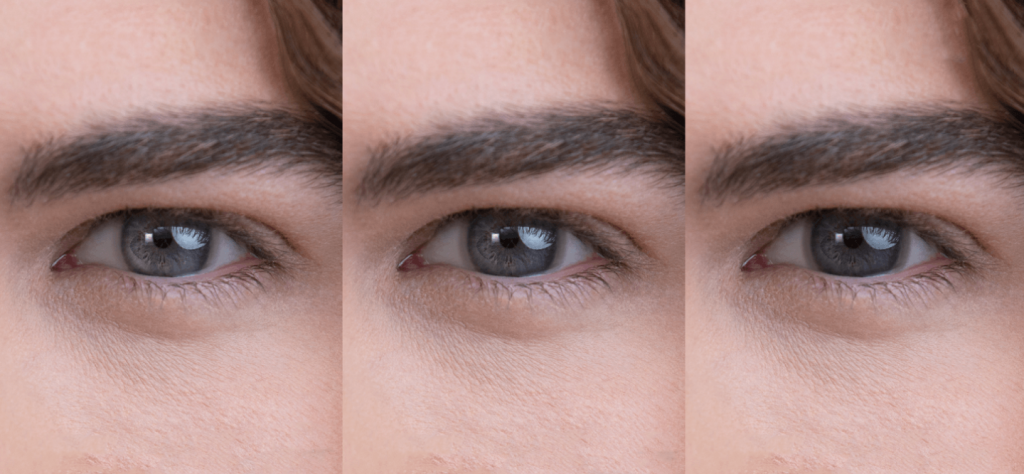Transition contact lenses type of contact includes breakthrough light-management technology. It allows the lenses to darken automatically when exposed to bright light. They do this without sacrificing visual acuity (sharpness of vision) or comfort.
In April 2018, the United States Food and Drug Administration (FDA) approved the first-ever transition contact lenses – Acuvue Oasys Transitions.
Acuvue Oasys with Transitions
(FDA-approved)

These innovative contacts balance the amount of indoor and outdoor light allowed to enter your eyes, including blue light from devices. When exposed to UV and/or HEV light, they darken slightly for protection without dramatically changing the appearance of your eyes.
You can use these transition contact lenses daily if you have myopia (nearsightedness) or hyperopia (farsightedness). Even those who do not have vision problems can wear them.
These are “biweekly” lenses, meaning they must be replaced approximately every 14 days. Like any type of contact lens, it is important to maintain good eye care practices. Transition contact lenses still have the risk of complications, such as infections.
Are Transition Contacts Safe & Effective?
The FDA provided clearance for the use of these transition contact lenses. This means that the governmental organization considers these contacts to be both safe and effective.
To reach this decision, the FDA reviewed different scientific evidence. For example, the FDA reviewed a clinical study of 24 subjects wearing contact lenses while driving during the day and/or night. The study showed no problems related to driving performance or vision among contact lens wearers.5
Also, the FDA looked at the Acuvue Oasys Contact Lenses with Transitions Light Intelligent Technology through the premarket notification 510(k) pathway.
A 510(k) refers to when a device manufacturer makes a premarket submission to the FDA to show their device is considerably equivalent to a predicate device. A predicate device is a legally marked medical device that a manufacturer may use as a reference to get approval from the FDA.
Approximately 45 million people wear contact lenses in the United States.
Centers for Disease Control and Prevention (CDC)
Where to Buy Glasses + Contacts
Best Overall: Warby Parker
Fastest Delivery: EyeBuyDirect
Also Great: Liingo
Best Place to Buy Contacts: Discount Contacts
How Do Transition Contact Lenses Work?
Transition contact lenses are similar to transition eyeglasses. They have a photochromic additive. This means your eye will filter visible light according to UV and High Energy Visible (HEV) light quantity.
When this happens, the lenses darken slightly to compensate for the increased sunlight. However, if you return indoors, your contact lenses become clear again within 90 seconds.
You’ll want to remember that while these contacts provide UV protection, they are not substitutes for UV-protective sunglasses or goggles. The contact lenses do not cover the entire eye and expose areas to harmful UVA/UVB radiation.
What Do They Look Like?
The contact lenses will have a clear-to-slightly tinted appearance in normal indoor lighting conditions. However, if you wear these transition lenses outside, they will become darker when exposed to UV and/or HEV light.

The lens manufacturer designed the contact lenses to minimize outward changes to your eye’s natural look.
However, the tint is temporary because these lenses fade quickly to clear when you’re no longer in direct sunlight.
Who Are Transition Contact Lenses For?
These transition contact lenses may be suitable if you are diagnosed with myopia (nearsightedness) or hyperopia (farsightedness).
The lenses do not correct astigmatism.
However, transition lenses may be worth considering if you have no vision problems but would like to enjoy the light management benefits.
Who Should Avoid Transition Contact Lenses?
If you have any of the following conditions, you should not use these transition lenses:
- Inflammation or infection in or around the eye
- Any eye disease, injury, or abnormality that impacts the cornea, conjunctiva (the mucous lining on the front of the eye), or eyelids
- Severe dry eye
- Diminished corneal sensitivity
- Red or irritated eyes
- Previously diagnosed condition that causes discomfort when you wear contacts
- Allergic reactions on the eye’s surface or surrounding issues that could be caused by contact lenses and/or their lens solution
- Systemic disease that could impact the eye or become more problematic when you wear contacts
Approximately 42 percent of Americans between the ages of 12 and 54 have myopia, while 5 to 10 percent of all Americans suffer from hyperopia.
the National Eye Institute,
Pros and Cons of Transition Contacts
Transition contacts have both advantages and disadvantages.
Pros of Transition Contacts
Here is a list of some of the benefits of wearing these contact lenses:
- Adapts to different light conditions. These lenses automatically adjust to light settings in little time. For example, when the lenses are exposed to outdoor light, they become more tinted.
- Improves vision at night. On average, you can experience fewer halos and starbursts by approximately 18 and 28 percent.
- Filters blue light. These lenses can block around 15 percent of blue light indoors and 55 percent in outdoor settings.
- Provides UV light protection. You can enjoy 100 percent protection against UVB rays and more than 99 percent against UVA rays.
- Contrasts color better. These lenses can enhance color contrast by up to 38 percent.
- Reduces vision problems caused by bright light. Indoor and outdoor bright light can make you squint or have trouble seeing clearly. These lenses help minimize this problem.
- Could enhance appearance. Some people may feel more confident because they wear contact lenses that do not affect their overall look.
- Doesn’t fog up. Unlike glasses which can fog up when you’re outdoors or in low-temperature environments, these contact lenses will maintain their clarity.
Cons of Transition Contacts
Here is a list of some of the downsides of wearing these contact lenses:
- Run the risk of eye infection. Despite the breakthrough technology, these contact lenses increase your risk of eye infections, like keratitis. These infections can happen due to poor hygiene and eye care practices at home.
- Increase the risk of blindness. If you develop a serious eye infection due to the lenses, you could suffer blindness. On an annual basis, blindness affects approximately 1 out of every 500 people who wear contact lenses.
- Becomes expensive. Buying contact lenses is not cheap and could increase your monthly expenses. Glasses are a more economical alternative.
- Doesn’t replace sunglasses. While transition contacts protect against UVA and UVB rays, parts of your eye and the surrounding area remain exposed to the radiation.
How Much Do Transition Lenses Cost?
Transition lenses’ prices will vary depending on where you purchase them.
For example, if you purchase these lenses at DiscountContactLenses, a box of six lenses costs you around $48. This is just under $100 for a three-month supply for both eyes.
However, if you are not sure about whether to spend the money or not, you can download a certificate from the home page of Acuvue Oasys Contact Lenses with Transitions Light Intelligent Technology.
This certificate will let you ask for free trial lenses from participating eye doctors. It is important to remember that you will have to pay for the eye exam and fitting fees.
Are They More Expensive Than Regular Contact Lenses?
Prices for contact lenses vary from one set to the next.
Costs will depend on:
- The severity of your vision problem
- The brand of contact lenses
- Additional product features
However, that aside, transition lenses fall within a similar price range. Also, with vision insurance, you may be able to save more on out-of-pocket expenses.
Where Can I Buy Transition Contacts?
Acuvue Oasys with Transitions
Discount Contact Lenses

Discount Contact Lenses has millions of contacts in stock, provides 24/7 customer support, and a best-price guarantee. They offer free returns and exchanges and torn lens replacement. We recommend them for all your contact lens needs.
Or you can buy transition contacts from a local drugstore retailer or an optometry clinic. You can speak with your optometrist or ophthalmologist to find out where to purchase transition contact lenses.
Summary
Transition lenses are contact lenses that provide extra protection from UV rays and blue light. They turn normally clear lenses into tinted ones when exposed to bright light. Consult your optometrist or ophthalmologist if you want to switch to transition lenses. They can help you decide which lens type is best for your eyes.
In this article
Best Places to Buy Contacts
Best Overall

Discount Contacts is our #1 recommendation to buy contacts online.
Also Great

GlassesUSA has a huge selection of contacts, glasses, & sunglasses.
Best Places to Buy Glasses
Best Overall

Warby Parker has stylish, high-quality frames at affordable prices.
Also Great

Liingo Eyewear is another great option to buy glasses online.
Best on a Budget

EyeBuyDirect has a wide variety of budget frames starting at $6.







